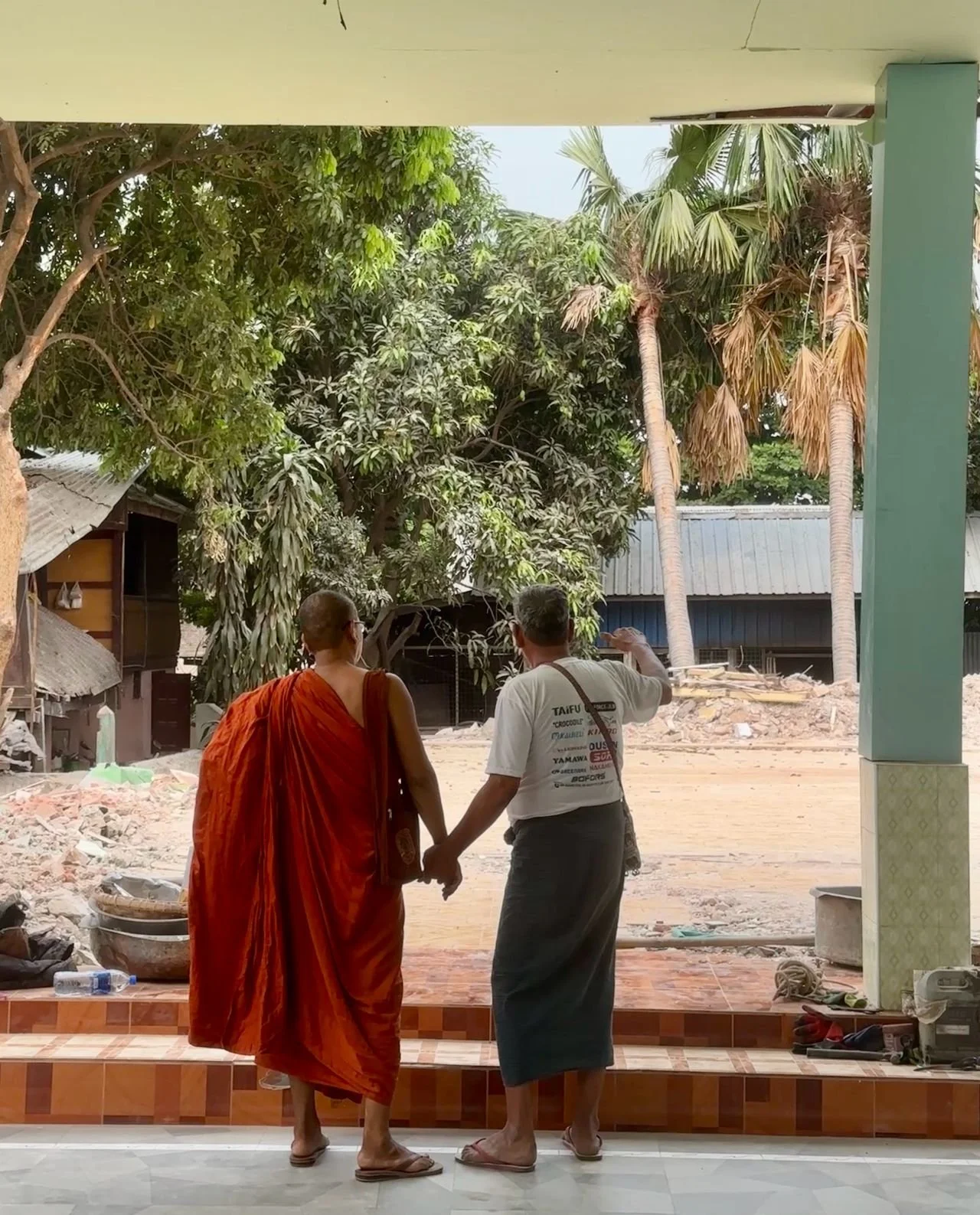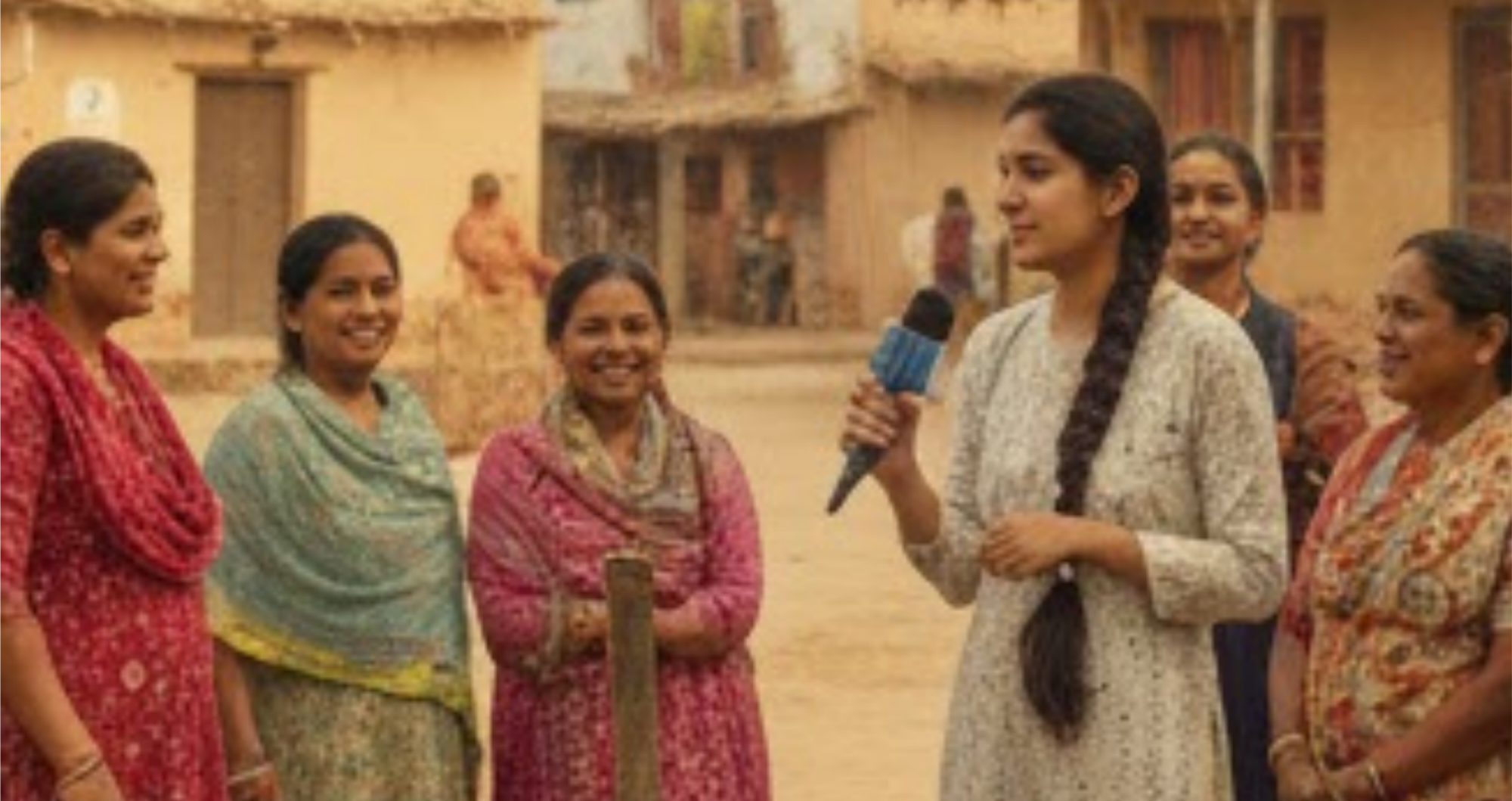Written By Janith Perera, Vedabhyas Kundu, PhD, Aaliyah Sharplin, Freya Jhugroo, and Kerenhappuch Theruvapalli
Introduction
When envisioning a new generation of peace, we believe two conceptual dynamics should serve as guiding principles: Servant Leadership and Nonviolent Communication (NVC). Together, these concepts enable a form of leadership rooted in service, empathy, and ethical dialogue—qualities with the power to transform communities from within. Servant Leadership, which views service as the highest form of leadership and embraces Nonviolent Communication as a core strategy for positively influencing communities, offers an effective and fitting alternative to traditional leadership models rooted in power, authority, and control.
We share these insights from grounded wisdom gained through our latest research endeavour. Between April and September 2025, Global Peace Let’s Talk coordinated a Participatory Action Research project titled Servant Leadership in Action, alongside a Training of Trainers (ToT) programme in Nonviolent Communication and Servant Leadership. This initiative brought together changemakers from diverse backgrounds to co-create knowledge on how servant leadership is practised in real-world community settings, particularly in relation to peacebuilding and development. This article presents some of our key research findings, highlighting how servant leadership and nonviolent communication intersect to shape a new generation of peacebuilders—leaders who serve, listen, and lead with compassion.
Servant Leadership and Nonviolent Communication
Servant leadership, as coined by Greenleaf (1970), is a philosophy in which the leader’s primary role is to serve others—placing the needs of followers above their own and investing in their growth and well-being (Smith, 2005; Spears, 2024). This approach shifts the focus from hierarchy to empowerment and ethical responsibility. Its relevance has been demonstrated across sectors, particularly in health (Demeke et al., 2024), education (Makirimani and Naicker, 2025), and social justice (Jeyaraj and Gandolfi, 2020). However, its broader significance within the continuum of community development remains under-researched, which became the galvanizing focus of our research project.
At the heart of servant leadership lies communication—an essential tool for building trust, resolving conflict, and fostering inclusion. Nonviolent communication, rooted in Gandhian principles and elaborated by Rosenberg (2015), offers a structured methodology for ethical dialogue and conflict transformation. Nonviolent communication is a holistic approach grounded in human interdependence, emphasizing nonviolence and human values in all communicative processes, from intrapersonal reflection to interpersonal engagement (Kundu, 2022, 2024). This communication ethos strengthens servant leadership by cultivating a positive communication ecosystem essential for sustainable peace and development.
Recognising that leadership is not a static role but a dynamic relationship between leaders and their communities, ToT participants, in their role as participatory action researchers, were invited to identify and interview a local leader they considered a servant leader from their community. These semi-structured interviews examined how servant leadership is practiced, its role in promoting peace and development, and the influence of the leader’s communication in driving collective action. This research culminated in the analysis of thirty-one community leaders, twenty-two male and nine female, representing diverse professional backgrounds—particularly in education, public service, religious institutions, and the military—across countries including Nigeria, Sri Lanka, Kenya, Burundi, Pakistan, Mexico, Ethiopia, DR Congo, Ghana, Uganda, and the United States.
Servant Leadership’s Contribution to Community Development
The lived experiences gathered through our research reveal servant leaders as individuals whose unique journeys reflect perseverance, dedication, and a deep commitment to their communities’ future. As we engaged with their life stories and learned about the work to which they have devoted their lives, the depth of each leader’s passion became unmistakably clear. Despite their diverse backgrounds, these leaders shared a common commitment to serving humanity, building peace, and nurturing prosperity. Their stories reveal that servant leadership is not merely a theoretical model but also a lived reality that empowers communities, fosters resilience, and creates spaces for healing and hope.
“...servant leadership is not merely a theoretical model but also a lived reality that empowers communities, fosters resilience, and creates spaces for healing and hope.”
Our study finds that effective community development requires leadership from within, grounded in a deep understanding of community needs enabled through active listening. Unlike traditional models based on authority and control, servant leaders prioritise collective well-being, working collaboratively and selflessly. Through active listening, they build trust and foster relational understanding, dismantling hierarchical barriers that often hinder progress. Their emphasis on emotional intelligence, especially when integrated into education and training, cultivates empathy and unity, particularly among youth. Each action reflects a commitment not to assert authority, but to serve with humility and care. An inspiring example of such servant leadership emerged in Nigeria’s Girau Community, where Alhaji Abdul Mohammed Lawal played a pivotal role in its development. His attentive listening, a hallmark of servant leadership, built relational trust and enabled him to engage locals by unpacking their concerns and offering sustainable solutions. This approach led to reduced crime and increased youth participation through mentorship and targeted training, demonstrating how active listening, grassroots engagement, and empathetic leadership can effectively mobilise communities and reduce anti-social behaviours.
Servant leaders also tackle challenges collectively, adopting a holistic approach and working collaboratively to shape the future of their communities, particularly through education. They prioritise youth—the most vulnerable and receptive to growth. ‘Build The Future Educational Consult’ is the legacy of servant leader Daniel Owusu Baah, from Ghana. The firm supports youth in the Greater Accra Region, helping them apply to international institutions, build academic skills, and prepare for leadership. Similarly, Nousheen Ubaid, from Pakistan, also embodies the spirit of servant leadership through her work in education. Though many parents didn’t understand her inclusive teaching approach, she built open communication with students and parents, sparking enthusiasm for cross-cultural collaboration. Her approach builds emotional safety, sparks creativity, and boosts academic success. Baah and Ubaid mentor youth, instilling emotional intelligence and acceptance—values their students carry forward, strengthening communities for generations.
A distinct finding of the research is that servant leadership is also emerging in contexts that many might find unexpected—such as the military. Traditionally known for its rigid and hierarchical structure, the military may seem an unlikely setting for servant leadership. Nevertheless, our study identified servant leaders who are part of the military. General Christopher Gwabin Musa, Nigeria’s Chief of Defence Staff, exemplifies how servant leadership can strengthen civil-military relations. His approach transcends the conventional role of defending national borders, emphasizing public service through civic engagement and promoting soft power strategies such as dialogue, inclusion, and trust-building. These efforts foster greater community involvement, rebuild trust between the armed forces and civilians, and contribute to addressing challenges like violent extremism and threats to public safety. By prioritizing ethical governance and community engagement, General Musa redefines military leadership through the lens of servant leadership. His emphasis on listening, foresight, and stewardship illustrates how these values can be effectively integrated into even the most hierarchical institutions.
In envisioning a new era of peace, the infusion of servant leadership into traditional power structures offers a transformative model—one that is people-centered, responsive, and aligned with the evolving demands of peace, security, justice, and development.
Nonviolent Communication Strengthening Servant Leadership for Peace and Development
Our analysis of servant leaders also reveals that using the strategies and tools of nonviolent communication (NVC) has been a critical factor in the success of all thirty-one leaders studied, with several of the previously mentioned examples serving as compelling evidence. This underscores the synergy between servant leadership and nonviolent communication in fostering sustainable peace. Together, these approaches offer a more effective model of leadership—one that prioritizes authentic connection, empathetic understanding, and community healing over command and control. Interestingly, many of these leaders we studied intuitively apply the principles of nonviolent communication, even without formal training in either framework. This suggests that their leadership style is not only intentional but also inherently oriented towards fostering mutual respect and deep engagement.
“In envisioning a new era of peace, the infusion of servant leadership into traditional power structures offers a transformative model—one that is people-centered, responsive, and aligned with the evolving demands of peace, security, justice, and development.”
Our findings elucidate how servant leaders leverage NVC to resolve conflict and build peace through three interconnected capabilities: observational capability (deep listening), relational capability (strategic patience), and systemic capability (collaborative problem-solving). These capacities not only enable leaders to cultivate trust and navigate complexity but also serve as foundational pillars for reimagining a new generation of peace leadership—one that is grounded in empathy, inclusivity, and sustainable transformation.
Deep Listening
A key factor in the success of inspirational community leaders who embody servant leadership is their capacity for 'deep listening’. This involves more than simply hearing what people say; it requires attuning to the underlying needs, emotions, and tensions within a community. This approach of deep listening is a core part of nonviolent communication, which encourages us to listen with an open mind and heart to understand people's feelings and needs without judgment. For a servant leader, deep listening is essential, as their primary goal is to understand and serve their community—not to impose directives upon it. We contend that deep listening functions as a form of observational capability, enabling leaders to recognize underlying needs and tensions before they escalate into violence, thereby transforming potential conflicts into opportunities for dialogue and mutual understanding. An illustrative example from our study is a tense standoff in Pangani, a suburb in Nairobi, Kenya, where Chief Johnson Amimo successfully averted conflict during the planned eviction of informal traders from a road reserve by engaging in a three-hour dialogue with the affected traders. This example, among several others, highlights that deep listening is a critical capacity emerging leaders must cultivate. It enables them to address community challenges and foster peace and development by championing nonviolence in thought, word, and deed (ahimsa), and by approaching struggles with the force of truth and love (Satyagraha)—the foundational principles of the Gandhian model of nonviolent communication.
Strategic Patience
Impactful community leaders demonstrate a strategic sense of patience, which in turn strengthens their relational capability. Our analysis shows that building meaningful relationships takes time and that lasting change cannot be rushed. For instance, in Uganda, Nantongo Teddy spent several months patiently building a relationship with a married couple experiencing marital difficulties. She voluntarily dedicated time to visit them, listened to both partners without judgment, and helped clarify the root causes of their challenges. Through gentle persuasion and encouragement, she fostered mutual respect between them, ultimately strengthening their relationship. Similarly, in Nigeria, Alhaji Abdul Mohammad Lawal facilitated multiple community dialogues to prevent outbreaks of mob violence. In one instance, he intervened when a thief was about to be lynched by an angry crowd. Drawing on his communication skills and deep patience, he appealed to the crowd’s moral conscience, urging them to respect the dignity of human life and uphold the principles of due legal process—successfully de-escalating a potentially violent situation. This relational capability is not simply about waiting—it involves the intentional cultivation of trust through consistent, respectful engagement that honors the natural pace of genuine transformation. Such patience ensures that all voices are heard and respected, leading to solutions that are truly owned by the community. This approach aligns closely with the principles of nonviolent communication, which emphasize addressing issues through an understanding of underlying needs and always seeking nonviolent alternatives.
Collaborative Problem-Solving
Our analysis also highlights the transformative power of collaborative problem-solving in cultivating ‘systemic capability’: the ability of leaders to unite diverse stakeholders to co-create solutions that are effective, inclusive, and enduring. Dr Zumra Nuru, founder of the Awra Amba community in Ethiopia, exemplifies this approach. His leadership, grounded in dialogue and mutual respect, prioritized collective voices over traditional authority. Rather than imposing decisions, he fostered open discussions, encouraging the exchange of ideas and resolution of differences. As a selfless servant leader, his patient listening and inclusive engagement enabled the community to dismantle harmful traditions, address gender inequality, and eliminate child exploitation. Today, men and women share responsibilities equally, and the community thrives on values such as ‘treat others the way you want to be treated’. This inclusive model, built on social justice and care for the vulnerable, including elders and those unable to work, has empowered Awra Amba to endure external hostility, displacement, and poverty. It stands as a testament to how systemic capability, rooted in servant leadership and nonviolent communication, can foster a resilient culture of peace and development. Such capability depends on holistic communication—empathetic listening and cooperative engagement. By nurturing shared understanding and collective action, leaders help communities redefine norms for resolving conflict and making decisions. In this context, conflict becomes an opportunity to surface and address unmet needs, reinforcing the idea that peace is not merely the absence of conflict, but the presence of communication practices that uphold human dignity and respond to deeper concerns. Thereby, servant leaders who leverage nonviolent communication embed peacebuilding into the very fabric of community life. Rather than positioning themselves as indispensable problem-solvers, they foster collective capacity for self-governance and mutual care—ensuring that peace becomes a shared, sustainable responsibility rather than a top-down directive.
Conclusion
Our research demonstrates that servant leadership and nonviolent communication are foundational to reimagining a new generation of peace leadership. When integrated, these approaches have the power to transform communities, strengthen relationships, and build lasting capacities for peace, coexistence, and development. The thirty-one case studies co-created in our study, some of which are presented in this article, demonstrate that leaders who embody these principles engage constructively with stakeholders, foster trust, and catalyze meaningful change. Our findings indicate that servant leaders who prioritise listening to their communities not only gain a deeper understanding of their needs but also cultivate meaningful relationships that enable the co-creation of effective, sustainable solutions. These solutions are not quick fixes; they require ongoing engagement and patience in order to foster long-term transformation. In some cases,
“By nurturing shared understanding and collective action, leaders help communities redefine norms for resolving conflict and making decisions. In this context, conflict becomes an opportunity to surface and address unmet needs, reinforcing the idea that peace is not merely the absence of conflict, but the presence of communication practices that uphold human dignity and respond to deeper concerns.”
sustainability is advanced by leveraging education to build the capacity of community members and foster emotional intelligence. In others, it involves strategically reshaping rigid hierarchies and traditional cultures into more flexible, context-sensitive practices.
These practices underscore the importance of nonviolent communication—particularly the value of deep listening, strategic patience, and collaborative problem-solving—as essential tools for systemic change. As we contend, nonviolent communication enhances the capabilities of servant leaders to reimagine peace leadership for a new generation, shifting dynamics from control to connection and enabling compassionate responses to conflict. In this context, we advocate placing servant leadership and nonviolent communication literacy at the core of peacebuilding efforts. These approaches foster systemic change that benefits both current and future generations. In a world facing complex challenges, they redefine leadership as service rooted in dignity, empathy, and shared humanity—laying the foundation for a more peaceful, just, and resilient future.
References
Demeke, G. W., van Engen, M. L., & Markos, S. (2024). Servant leadership in the healthcare literature: A systematic review. Journal of Healthcare Leadership, 16, 1–14. https://doi.org/10.2147/JHL.S440160
Greenleaf, R. K. (1970). The servant as leader. http://www.ediguys.net/Robert_K_Greenleaf_The_Servant_as_Leader.pdf
Jeyaraj, J. J., & Gandolfi, F. (2020). Empowering students for social justice through a critical pedagogy inspired framework of servant leadership. Pedagogy, Culture & Society. https://doi.org/10.1080/14681366.2020.1742895
Kundu, V. (2022). Nonviolent communication for peaceful co-existence. In L. R. Kurtz (Ed.), Encyclopedia of Violence, Peace, and Conflict (Vol. 4). Elsevier, Academic Press.
Kundu, V. (2024). Practicing Nonviolent Communication. VL Media Solutions.
Makirimani, R., & Naicker, S. (2025). Servant leadership attributes for raising teacher morale in primary schools. South African Journal of Childhood Education, 15(1). https://journals.co.za/doi/abs/10.4102/sajce.v15i1.1596
Rosenberg, M. (2015). Nonviolent communication: A language of life. Puddle Dancer Press.
Smith, C. (2005). The leadership theory of Robert K. Greenleaf. https://www.boyden.com/media/just-what-the-doctor-ordered-15763495/Leadership%20%20Theory_Greenleaf%20Servant%20Leadership.pdf
Spears, L. C. (2024). A journey in servant-leadership. International Journal of Servant-Leadership, 18. https://doi.org/10.33972/ijsl.394
Acknowledgements
While thirty-one Participatory Action Researchers contributed to this project and played a vital role in advancing scholarship on servant leadership and nonviolent communication, we would like to acknowledge a few whose interviews were particularly instrumental in illustrating our findings with specific examples. These individuals include Dr. Ramat Alliu-Mohammed (Nigeria), Esperanza Gyamfi (Ghana), Nuzhat Mustafa (Pakistan), Dr. Safiya Stephanie Musa (Nigeria), Catherine Namuyimbwa (Uganda), and Asmare Shetahun Alemneh (Ethiopia).
The research presented in this article is led by Global Peace Let’s Talk (GPLT), a not-for-profit organisation based in London, United Kingdom, comprising a global network of individuals committed to peace. As an advocacy and training body, GPLT leads a range of initiatives that promote peace, justice, and sustainable development.
Issue 03 | Reimagining a New Generation of Peace
-

No Planet, No Peace: Reimagining Peacebuilding through Planetary Stewardship
-

When the Earth Shook, Faith Held Us Together
-

Reimagining Peace through Rumi’s Lenses: A Voyage into Poetic Wisdom, Politics, Diplomacy, and the Transcendental
-

An Alternative Peacebuilding Vision in a Post-Liberal Era
-

Sing My Soul
-

Reimagining a New Generation of Peace with Servant Leadership and Nonviolent Communication
-

Threading the Future: Mentoring the Next Generation of Peacebuilders
-

If We Can Teach AI to Practise Empathy: Nonflict and a Generation of Peacemakers
-

Peace Leader Spotlight | From Grandmother’s Legacy to Global Peacebuilding: Issah Toha Shamsoo
-

Young Leaders for Peace: Meeting the Moment through Youth Peace Leadership Development at the University for Peace
-

Reimagining Peace Through Young Voices in India: Spotlight on Women Journalists and Their Stories
-

Peace Dwelling and Belonging: Stan Amaladas on rethinking what it means to live well with each other
-

Pockets and Peace Design: A collaborative design framework to advance health equity and build peace
-

From Shrinking Spaces to Shared Strategies: Insights from Central Asia on how to build collective action for conflict prevention and peacebuilding
-

From War Memories to Peace Encounters: Constructive Usage of Veteran Experience
-

Call for Submissions | Issue 04

